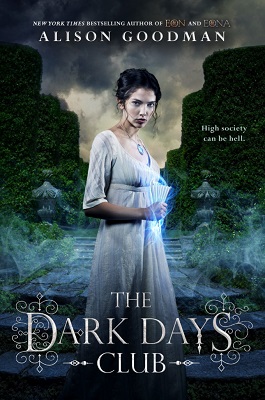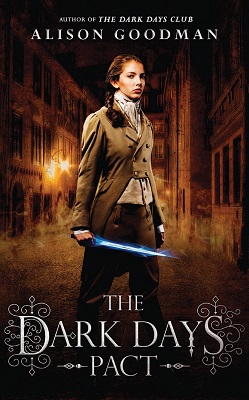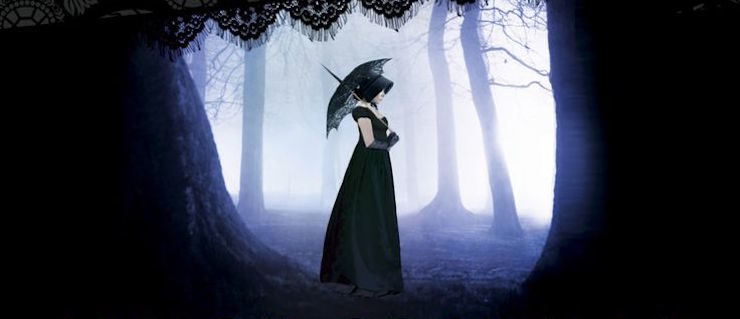It is a truth universally acknowledged that young adult SFF doesn’t get the respect it deserves. Sure, the ratio of chaff to wheat is depressingly high, but frankly that’s not any different than all the natter being cranked out in adult fiction. Or television or movies for that matter. Point is, you can’t discount a whole subgenre just because a lot of it sticks to the same tired formula, otherwise you’ll miss amazing gems like Alison Goodman’s passionate and powerful Lady Helen trilogy.
Only the first two are out so far, The Dark Days Club and The Dark Days Pact, but if you dig YA, Regency fic, Gothic romance, monster hunting, and intersectional feminism and diversity, then this is a series you must read. It’s Buffy the Vampire Slayer meets Jane Austen for the YA set, and it’s even better than you think.
It’s 1812 and 18-year-old Lady Helen Wrexhall is days away from being presented at court, thereby becoming eligible for a high society marriage. Her parents’ scandalous death put behind her, she and her elder brother are well on their way to becoming desirable members of London’s fashionable set. But that’s not the life fate has in store for her. The dashing, brooding Lord Carlston turns her life upside down by revealing not only that she’s really a Reclaimer—a superpowered human that hunts Deceivers, demon-like creatures that feed on human experiences—but that she’s also a Direct Inheritor; Reclaimer powers are almost never passed down genetically, but when they are, as in Lady Helen’s case since her mother was also a Reclaimer, it’s usually to face in battle a Grand Deceiver.
 In The Dark Days Club, author Alison Goodman introduces us to Helen and the government-sanctioned organization dedicated to protecting England from supernatural baddies. Things get trickier in the sequel, The Dark Days Pact, as Helen prepares to take her oath and uncover her nemesis, but turns out there’s more wickedness amongst the so-called heroes than she expects.
In The Dark Days Club, author Alison Goodman introduces us to Helen and the government-sanctioned organization dedicated to protecting England from supernatural baddies. Things get trickier in the sequel, The Dark Days Pact, as Helen prepares to take her oath and uncover her nemesis, but turns out there’s more wickedness amongst the so-called heroes than she expects.
While most sequels fail to live up to the heights of the original, in this case Dark Days Pact is even better than Dark Days Club. No sophomore slump for this trilogy despite the introduction of a love triangle. With each entry the series gets stronger, more visceral, and more epic in scope. What starts out as a quiet, high society Regency drama now spans a vast cast with deep connections to powerful players and global threats. Lady Helen’s focus is set on the machinations of Reclaimers in the fashionable areas of England, but her world and worldview have expanded exponentially in only a few months.
What I love the most about the Lady Helen series is how Goodman demonstrates how easy it is to add diversity to historical fiction. I can’t tell you how many historical fiction novels I’ve read, adult and young adult alike, with a cast entirely straight, white, and dominated by men. I’m so tired of hearing that historical fiction wouldn’t be “accurate” if it was diverse, as if target groups didn’t exist until the 19th century. If diversity does eke its way in, it’s usually in the form of a overweight person in the “fatty go boom” stereotype, a magical disability, an enslaved PoC, or a tragic gay person. I’d rather not have diversity at all if my only options are tokenism or stereotypes.
Goodman’s Regency England is populated with a wide range of people. In other words, the Lady Helen series is realistic and historically accurate. Quinn is a Pacific Islander, one of Lady Helen’s dancing partners is half-Indian, and people of African ancestry make regular appearances in the background, not to mention an interracial romance between two important secondaries. Body types are also wonderfully varied and never troped—Darby is muscular and several women are fabulously fat. And while I won’t reveal who for spoilers, an important character is gay and their identity plays a crucial role in the sequel. I don’t know if Goodman hired sensitivity readers or not, but she’s done a lovely job of inclusion and representation. Of course there’s always room for more diversity—I’d like to see some disabled characters and people with mental illness that isn’t demonic in nature—but Goodman’s still miles beyond most of her historical fantasy colleagues.
Given that the Lady Helen series is a romance as much as it is a historical fantasy, a love triangle is basically obligatory. This time around, however, she tweaks the formula. Carlston isn’t just a gloomy Brontean hero with tousled locks and a penetrating glare. He’s grumpy for a reason, and while his secrets have secrets he guards them not to punish others but to protect them from himself. Underneath the gruff exterior, he’s a pretty decent dude or, to get all Austen-y, he’s the bastard lovechild of Mr Darcy and Captain Wentworth. Remove the obstacles keeping them apart and Helen and Carlston would make a solid couple, their personalities complementing and bettering each other.
 The other male point of the triangle, the Duke of Selburn, is where Goodman really sharpens her point. Selburn is the Regency embodiment of the dreaded “nice guy.” He’s selected Helen as his romantic partner regardless of her thoughts on the matter. He constantly, intentionally or otherwise, manipulates society’s dismissive views of women to his advantage to further ensnare Helen. She was flattered by his attentions at first, but with her advancement in the Dark Days Club her polite rebuff becomes a firm rejection … and yet he still continues to entwine himself in her personal life.
The other male point of the triangle, the Duke of Selburn, is where Goodman really sharpens her point. Selburn is the Regency embodiment of the dreaded “nice guy.” He’s selected Helen as his romantic partner regardless of her thoughts on the matter. He constantly, intentionally or otherwise, manipulates society’s dismissive views of women to his advantage to further ensnare Helen. She was flattered by his attentions at first, but with her advancement in the Dark Days Club her polite rebuff becomes a firm rejection … and yet he still continues to entwine himself in her personal life.
Tying into this are notions of gender identity and the Regency version of feminism. Simply by being a Reclaimer Helen challenges what it means to be a woman in her society. Can she still be feminine with a dagger in her hand and her hair cropped short? Is she still a women when she disguises herself as a man? If she cannot participate in what her society deems traditionally female activities—becoming accomplished, getting married, having children, running a household—does that make her an undesirable as a female companion? She sees the consequences of being treated by society as inconsequential (Darby and the other maids), silly (Pug), fallen (Delia), and the unworthy (prostitutes like Lizzie and street urchins like Sprat). What does it mean for her to willingly step into the role of a disgraced woman?
No matter how many times she proves them wrong, nearly every man and woman she meets constantly force upon Helen their disparaging opinions on women and femininity. She’s dismissed as too weak and over emotional and demeaned as gullible and ignorant. To borrow a phrase, she must work twice as hard for to go half as far as her male counterparts. She’s heard these degradations so much that even as she battles great evils she must talk herself into believing she can be better. But again, standing up and pushing back clashes against how Helen defines femininity and femaleness. Ultimately Helen has to choose her own labels and find meaning in her new identity, but since this is YA it’s all about the bildungsroman journey and less the maturity destination, one I can’t wait to read.
Only the first two of the three books in the series have been published so far, but it’s safe to say Goodman’s trilogy will end up one people will be reading for years to come. The writing is beautiful, nuanced, and evocative, the plot action-packed, and the characters alternately bewitching and haunting. Not everyone will relish the preponderance of Regency details or the slow burn of the main arc or romance, but trust me, Lady Helen is worth the wait. Each book is well over 400 pages yet I still consumed both in a few days, mostly because I simply couldn’t put them down. This is a “just one more chapter” series if ever I saw one. There’s a reason why the first novel made my Best of YA list for 2016.
Top image: selection from the hardcover edition of The Dark Days Club (Penguin Young Readers, 2016)
Alex Brown is a teen librarian, writer, geeknerdloserweirdo, and all-around pop culture obsessive who watches entirely too much TV. Keep up with her every move on Twitter and Instagram, or get lost in the rabbit warren of ships and fandoms on her Tumblr.










